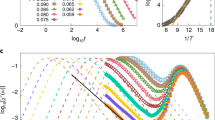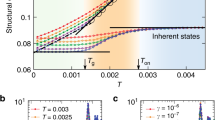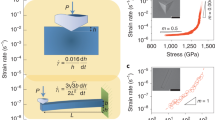Abstract
Understanding the underlying nature of dynamical correlations believed to drive the bulk glass transition is a long-standing problem. Here we show that the form of spatial gradients of the glass transition temperature and structural relaxation time near an interface indeed provide signatures of the nature of relaxation in bulk glass-forming liquids. We report the results of long-time, large-system molecular dynamics simulations of thick glass-forming polymer films with one vapour interface, supported on a dynamically neutral substrate. We find that gradients in the glass transition temperature and logarithm of the structural relaxation time nucleated at a vapour interface exhibit two distinct regimes: a medium-ranged, large-amplitude exponential gradient, followed by a long-range slowly decaying tail that can be described by an inverse power law. This behaviour disagrees with multiple proposed theories of glassy dynamics but is predicted by the ‘elastically collective nonlinear Langevin equation’ theory as a consequence of two coupled mechanisms: a medium-ranged interface-nucleated gradient of surface-modified local caging constraints, and an interfacial truncation of a long-ranged collective elastic field. These findings support a coupled spatially local–nonlocal mechanism of activated glassy relaxation and kinetic vitrification in both the isotropic bulk and in broken-symmetry films.
This is a preview of subscription content, access via your institution
Access options
Access Nature and 54 other Nature Portfolio journals
Get Nature+, our best-value online-access subscription
$29.99 / 30 days
cancel any time
Subscribe to this journal
Receive 12 print issues and online access
$209.00 per year
only $17.42 per issue
Buy this article
- Purchase on Springer Link
- Instant access to full article PDF
Prices may be subject to local taxes which are calculated during checkout



Similar content being viewed by others
Data availability
All relevant data are included in the paper and/or its Supplementary Information files. Raw simulation trajectory files, which are prohibitively large, are available upon reasonable request from D.S.S.
Code availability
All results in this paper employed openly available codes and/or standard numerical algorithms.
References
Cavagna, A. Supercooled liquids for pedestrians. Phys. Rep. 476, 51–124 (2009).
Debenedetti, P. G. & Stillinger, F. H. Supercooled liquids and the glass transition. Nature 410, 259–267 (2001).
Angell, C. A. Formation of glasses from liquids and biopolymers. Science 267, 1924–1935 (1995).
Adam, G. & Gibbs, J. H. On the temperature dependence of cooperative relaxation properties in glass-forming liquids. J. Chem. Phys. 43, 139–146 (1965).
Kirkpatrick, T. R., Thirumalai, D. & Wolynes, P. G. Scaling concepts for the dynamics of viscous liquids near an ideal glassy state. Phys. Rev. A 40, 1045–1054 (1989).
Lubchenko, V. & Wolynes, P. G. Theory of structural glasses and supercooled liquids. Annu. Rev. Phys. Chem. 58, 235–266 (2007).
White, R. P. & Lipson, J. E. Polymer free volume and its connection to the glass transition. Macromolecules 49, 3987–4007 (2016).
Long, D. & Lequeux, F. Heterogeneous dynamics at the glass transition in van der Waals liquids, in the bulk and in thin films. Eur. Phys. J. E 4, 371–387 (2001).
Chandler, D. & Garrahan, J. P. Dynamics on the way to forming glass: bubbles in space-time. Annu. Rev. Phys. Chem. 61, 191–217 (2010).
Dyre, J. C. Colloquium: the glass transition and elastic models of glass-forming liquids. Rev. Mod. Phys. 78, 953–972 (2006).
Hall, R. W. & Wolynes, P. G. The aperiodic crystal picture and free-energy barriers in glasses. J. Chem. Phys. 86, 2943–2948 (1987).
Mirigian, S. & Schweizer, K. S. Elastically cooperative activated barrier hopping theory of relaxation in viscous fluids. I. General formulation and application to hard sphere fluids. J. Chem. Phys. 140, 194506 (2014).
Mirigian, S. & Schweizer, K. S. Elastically cooperative activated barrier hopping theory of relaxation in viscous fluids. II. Thermal liquids. J. Chem. Phys. 140, 194507 (2014).
Forrest, J. A. & Dalnoki-Veress, K. The glass transition in thin polymer films. Adv. Colloid Interface Sci. 94, 167–195 (2001).
Alcoutlabi, M. & McKenna, G. B. Effects of confinement on material behaviour at the nanometre size scale. J. Phys. Condens. Matter 17, R461–R524 (2005).
Baschnagel, J. & Varnik, F. Computer simulations of supercooled polymer melts in the bulk and in confined geometry. J. Phys. Condens. Matter 17, R851–R953 (2005).
Ediger, M. D. & Forrest, J. A. Dynamics near free surfaces and the glass transition in thin polymer films: a view to the future. Macromolecules 47, 471–478 (2014).
Li, Y. et al. Surface diffusion in glasses of rod-like molecules posaconazole and itraconazole: effect of interfacial molecular alignment and bulk penetration. Soft Matter 16, 5062–5070 (2020).
Ediger, M. D. Perspective. Highly stable vapor-deposited glasses. J. Chem. Phys. 147, 210901 (2017).
Simmons, D. S. An Emerging unified view of dynamic interphases in polymers. Macromol. Chem. Phys. 217, 137–148 (2016).
Keddie, J. L., Jones, R. A. L. & Cory, R. A. Size-dependent depression of the glass transition temperature in polymer films. Europhys. Lett. 27, 59–64 (1994).
Jancar, J. et al. Current issues in research on structure-property relationships in polymer nanocomposites. Polymer 51, 3321–3343 (2010).
Christie, D., Register, R. A. & Priestley, R. D. Direct measurement of the local glass transition in self-assembled copolymers with nanometer resolution. ACS Cent. Sci. 4, 504–511 (2018).
Wunderlich, B. Reversible crystallization and the rigid-amorphous phase in semicrystalline macromolecules. Prog. Polym. Sci. 28, 383–450 (2003).
Jackson, C. L. & McKenna, G. B. The glass transition of organic liquids confined to small pores. J. Non-Cryst. Solids 131-133, 221–224 (1991).
Schweizer, K. S. & Simmons, D. S. Progress towards a phenomenological picture and theoretical understanding of glassy dynamics and vitrification near interfaces and under nanoconfinement. J. Chem. Phys. 151, 240901 (2019).
Richert, R. Dynamics of nanoconfined supercooled liquids. Annu. Rev. Phys. Chem. 62, 65–84 (2011).
Napolitano, S., Glynos, E. & Tito, N. B. Glass transition of polymers in bulk, confined geometries and near interfaces. Rep. Prog. Phys. 80, 036602 (2017).
Stevenson, J. D. & Wolynes, P. G. On the surface of glasses. J. Chem. Phys. 129, 234514 (2008).
Merabia, S., Sotta, P. & Long, D. Heterogeneous nature of the dynamics and glass transition in thin polymer films. Eur. Phys. J. E 15, 189–210 (2004).
White, R. P. & Lipson, J. E. G. Dynamics across a free surface reflect interplay between density and cooperative length: application to polystyrene. Macromolecules 54, 4136–4144 (2021).
Salez, T., Salez, J., Dalnoki-Veress, K., Raphaël, E. & Forrest, J. A. Cooperative strings and glassy interfaces. Proc. Natl Acad. Sci. USA 112, 8227 (2015).
Phan, A. D. & Schweizer, K. S. Influence of longer range transfer of vapor interface modified caging constraints on the spatially heterogeneous dynamics of glass-forming liquids. Macromolecules 52, 5192–5206 (2019).
Mangalara, J. H., Marvin, M. D., Wiener, N. R., Mackura, M. E. & Simmons, D. S. Does fragility of glass formation determine the strength of Tg-nanoconfinement effects? J. Chem. Phys. 146, 104902 (2017).
Hanakata, P. Z., Douglas, J. F. & Starr, F. W. Local variation of fragility and glass transition temperature of ultra-thin supported polymer films. J. Chem. Phys. 137, 244901 (2012).
Zhou, Y. & Milner, S. T. Short-time dynamics reveals Tg suppression in simulated polystyrene thin films. Macromolecules 50, 5599–5610 (2017).
Diaz-Vela, D., Hung, J.-H. & Simmons, D. S. Temperature-independent rescaling of the local activation barrier drives free surface nanoconfinement effects on segmental-scale translational dynamics near Tg. ACS Macro Lett 7, 1295–1301 (2018).
Scheidler, P., Kob, W. & Binder, K. Cooperative motion and growing length scales in supercooled confined liquids. Europhys. Lett. 59, 701–707 (2002).
Ghanekarade, A., Phan, A. D., Schweizer, K. S. & Simmons, D. S. Nature of dynamic gradients, glass formation and collective effects in ultrathin freestanding films. Proc. Natl Acad. Sci. USA 118, e2104398118 (2021).
Schmidtke, B., Hofmann, M., Lichtinger, A. & Rössler, E. A. Temperature dependence of the segmental relaxation time of polymers revisited. Macromolecules 48, 3005–3013 (2015).
Kob, W., Roldán-Vargas, S. & Berthier, L. Non-monotonic temperature evolution of dynamic correlations in glass-forming liquids. Nat. Phys. 8, 164–167 (2012).
Hocky, G. M., Berthier, L., Kob, W. & Reichman, D. R. Crossovers in the dynamics of supercooled liquids probed by an amorphous wall. Phys. Rev. E 89, 052311 (2014).
Mirigian, S. & Schweizer, K. S. Dynamical theory of segmental relaxation and emergent elasticity in supercooled polymer melts. Macromolecules 48, 1901–1913 (2015).
Phan, A. D. & Schweizer, K. S. Theory of the spatial transfer of interface-nucleated changes of dynamical constraints and its consequences in glass-forming films. J. Chem. Phys. 150, 044508 (2019).
White, R. P. & Lipson, J. E. G. To understand film dynamics look to the bulk. Phys. Rev. Lett. 125, 058002 (2020).
Napolitano, S. & Wübbenhorst, M. Structural relaxation and dynamic fragility of freely standing polymer films. Polymer 51, 5309–5312 (2010).
Paeng, K., Swallen, S. F. & Ediger, M. D. Direct measurement of molecular motion in freestanding polystyrene thin films. J. Am. Chem. Soc. 133, 8444–8447 (2011).
Mirigian, S. & Schweizer, K. S. Theory of activated glassy relaxation, mobility gradients, surface diffusion and vitrification in free standing thin films. J. Chem. Phys. 143, 244705 (2015).
Chowdhury, M. et al. Spatially distributed rheological properties in confined polymers by noncontact shear. J. Phys. Chem. Lett. 8, 1229–1234 (2017).
Hao, Z. et al. Mobility gradients yield rubbery surfaces on top of polymer glasses. Nature 596, 372–376 (2021).
Xie, S.-J. & Schweizer, K. S. A collective elastic fluctuation mechanism for decoupling and stretched relaxation in glassy colloidal and molecular liquids. J. Chem. Phys. 152, 034502 (2020).
Li, Y. et al. Surface diffusion is controlled by bulk fragility across all glass types. Phys. Rev. Lett. 128, 075501 (2022).
Evans, C. M., Deng, H., Jager, W. F. & Torkelson, J. M. Fragility is a key parameter in determining the magnitude of Tg-confinement effects in polymer films. Macromolecules 46, 6091–6103 (2013).
Baglay, R. R. & Roth, C. B. Communication: experimentally determined profile of local glass transition temperature across a glassy-rubbery polymer interface with a Tg difference of 80 K. J. Chem. Phys. 143, 111101 (2015).
Huang, X. & Roth, C. B. Optimizing the grafting density of tethered chains to alter the local glass transition temperature of polystyrene near silica substrates: the advantage of mushrooms over brushes. ACS Macro Lett. 7, 269–274 (2018).
Mei, B., Zhou, Y. & Schweizer, K. S. Experimental test of a predicted dynamics-structure-thermodynamics connection in molecularly complex glass-forming liquids. Proc. Natl Acad. Sci. USA 118, e2025341118 (2021).
Grest, G. & Kremer, K. Molecular-dynamics simulation for polymers in the presence of a heat bath. Phys. Rev. A 33, 3628–3631 (1986).
Mackura, M. E. & Simmons, D. S. Enhancing heterogenous crystallization resistance in a bead-spring polymer model by modifying bond length. J. Polym. Sci. B Polym. Phys. 52, 134–140 (2014).
Ivancic, R. J. S. & Riggleman, R. A. Dynamic phase transitions in freestanding polymer thin films. Proc. Natl Acad. Sci. USA 117, 25407–25413 (2020).
Vogel, H. Das temperatur-Abhängigkeitsgesetz der Viskosität von Flüssigkeiten. Phys. Zeit 22, 645–646 (1921).
Fulcher, G. S. Analysis of recent measurements of the viscosity of glasses. J. Am. Ceram. Soc. 8, 339–355 (1925).
Acknowledgements
D.S.S. and A.G. have been supported by the National Science Foundation (NSF) CAREER Award under grant no. DMR-1849594.
Author information
Authors and Affiliations
Contributions
The paper and Supplementary Information were written based on the contributions of all authors. A.G. performed all simulations under the supervision of D.S.S. A.G. and D.S.S. jointly conceived of and analysed all simulations. A.D.P. and K.S.S. performed all ECNLE theory analytical analysis and numerical calculations.
Corresponding authors
Ethics declarations
Competing interests
The authors declare no competing interests.
Peer review
Peer review information
Nature Physics thanks the anonymous reviewers for their contribution to the peer review of this work
Additional information
Publisher’s note Springer Nature remains neutral with regard to jurisdictional claims in published maps and institutional affiliations.
Supplementary information
Supplementary Information
Detailed simulation methods, Supplementary Figs. 1–6 and theory details.
Rights and permissions
Springer Nature or its licensor (e.g. a society or other partner) holds exclusive rights to this article under a publishing agreement with the author(s) or other rightsholder(s); author self-archiving of the accepted manuscript version of this article is solely governed by the terms of such publishing agreement and applicable law.
About this article
Cite this article
Ghanekarade, A., Phan, A.D., Schweizer, K.S. et al. Signature of collective elastic glass physics in surface-induced long-range tails in dynamical gradients. Nat. Phys. 19, 800–806 (2023). https://doi.org/10.1038/s41567-023-01995-8
Received:
Accepted:
Published:
Issue Date:
DOI: https://doi.org/10.1038/s41567-023-01995-8



